


 2009
2009


 (Advert 1954)
(Advert 1954)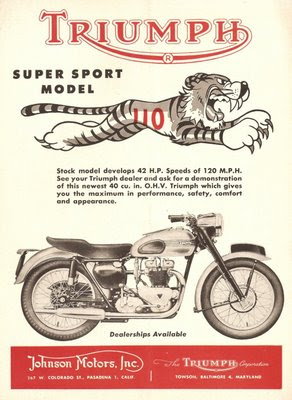 (Johnson Motors Inc. US Advert 1954)
(Johnson Motors Inc. US Advert 1954) Welnu in Castletown op het Isle of Man kwamen wij
Welnu in Castletown op het Isle of Man kwamen wij 

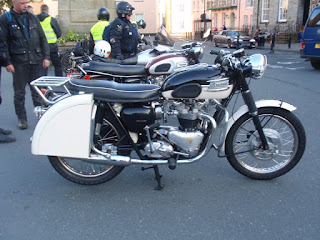 A Triumph Tiger 110 650 cc 1960
A Triumph Tiger 110 650 cc 1960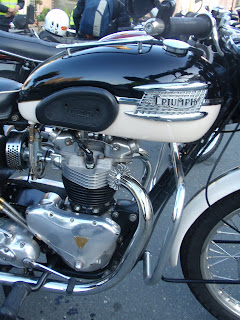
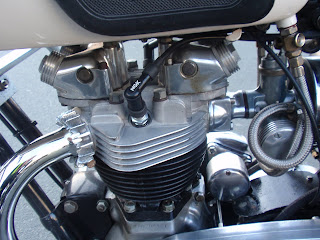
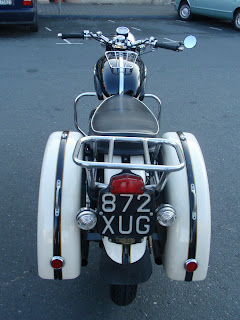
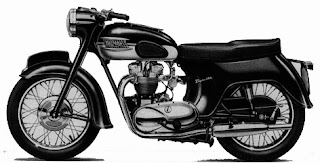 panels from the smaller twins in 1961 which earned it the nickname 'bathtub' and made it look outdated, so was replaced by the Triumph Bonneville.
panels from the smaller twins in 1961 which earned it the nickname 'bathtub' and made it look outdated, so was replaced by the Triumph Bonneville. The Triumph Tiger 110 650 cc OHV Twin was Triumph's fastest production motorcycle to date, developed for the American market which wanted a higher power output. The T100 first appeared in 1954. Originally produced with a cast iron cylider block and head, this was quickly replaced with a light alloy cylinder head with special airways to improve cooling and austenitic iron valve set inserts. The external oil fed pipes were also replaced with internal oilways via the pushrod tubes.
The Triumph Tiger 100 was named because it was capable of 100 mph (160 km/h), so it was an obvious marketing idea to call the new bike the Tiger 110 - although technically the best one way speed obtained by The Motor Cycle magazine in tests was 109 mph (175 km/h) (with a strong tail wind) - but the speedometer was reading 114 mph (183 km/h), so there was a margin of error.
By 1961, the Tiger 110 was being replaced by more modern models, such as the T120 and had acquired the enclosed panels from the Triumph Twenty One which were fashionable at the time but gained it the nickname of the 'bathtub'.
 World Speed Record:
World Speed Record: On 5 September 1962, at Bonneville Salt Flats American racer Bill Johnson secured the world land speed record on a heavily modified Triumph T110 with a top speed of 224.57 mph (361.41 km/h). This success led to the development of the Tiger T110's successor - the Triumph Bonneville.
On 5 September 1962, at Bonneville Salt Flats American racer Bill Johnson secured the world land speed record on a heavily modified Triumph T110 with a top speed of 224.57 mph (361.41 km/h). This success led to the development of the Tiger T110's successor - the Triumph Bonneville.(Tekstbron: Wapedia )




But now a Triton completely different...
 I’m not sure about you, but I’d love to wake up on Christmas Day and find this in my garage. This gorgeous Triton is the brainchild of French designers Frank Charriaut and Vincent Prat from Southsiders MC, and was built by the extraordinarily talented Daniel Delfour, one of France’s leading motorcycle builders.
I’m not sure about you, but I’d love to wake up on Christmas Day and find this in my garage. This gorgeous Triton is the brainchild of French designers Frank Charriaut and Vincent Prat from Southsiders MC, and was built by the extraordinarily talented Daniel Delfour, one of France’s leading motorcycle builders.
As with most beautiful motorcycles, there’s a story behind ‘CP Project #1′. It was inspired by a trip to the 2008 Legend Of The Motorcycle event in California; Delfour’s exquisite Norton Ala’verda caused a stir there, so the three friends hatched plans for a sequel. “As English motorcycle fans, we choose to use a Norton featherbed frame and a Triumph 750 Bonneville engine,” says Vincent. “But we didn’t want to make the thousandth café racer or Triton; we decided to follow our own road. We started designing a mix of Batman’s motorcycle with a T.Rex fastback and Cat Woman’s curves. Inspiration came directly from the culture of comics.”
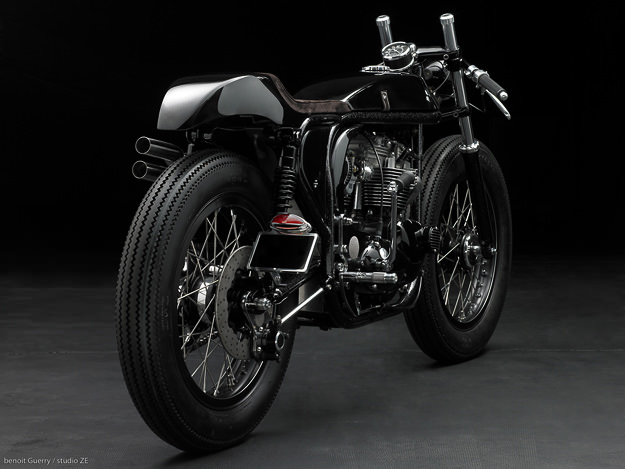
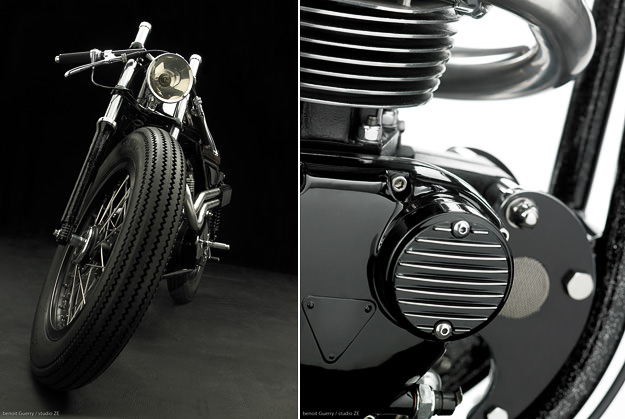
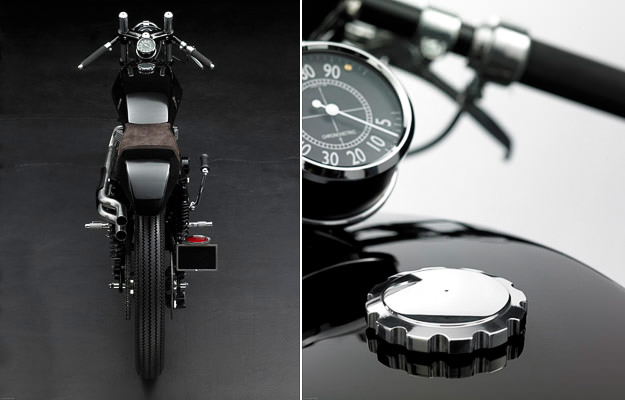
 (Bron:)
(Bron:)



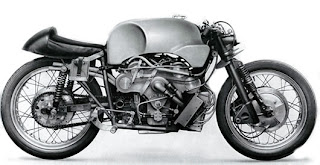 Moto Guzzi 500cc V8 - Otto cilindri 500cc
Moto Guzzi 500cc V8 - Otto cilindri 500ccOne of the fascinating, but lesser known, vintage motorcycle engines is the Moto Guzzi 500cc V8, built for racing from 1955 to 1957. It was a 90 degree DOHC with 8 individual Dell'Orto carburetors. In 1955, it produced 68 hp at 12,000 rpm and in its final configuration in 1957, put out 72 hp at 12 grand and probably sounded wonderful while doing so. Interestingly, it began with a 6 speed gearbox, then dropped to a 5 speed and finally ran as a 4 speed.

Moto Guzzi 500cc V8 racer with dustbin fairing
The motorcycle was raced with 2 different fairings, one much like a modern fairing leaving the front wheel exposed and the other, the famous "dustbin" with greater coverage, the choice depending on the track.
Though development was progressing nicely, Moto Guzzi withdrew from racing after 1957 so I guess we'll never know how it might have done in later years.
A lot of early engineering was far more impressive than some folks might think. High tech racing isn't some recent development, the guys were hard at work building bikes like this 60 and 70 years ago. With some of the recent V8 motorcycles sporting huge automotive engines, you might get the impression they all have to be massive hulks but there have been some beauties over the years like the Morbidelli V8 and the Yamaha based V8s built by Ian Drysdale. The Moto Guzzi goes back quite a bit further. I like it a lot.
The photos included here are from Moto Guzzi: The Complete History, an excellent book for a little cold weather reading, highly recommended.
 Moto Guzzi 500cc V8 engine
Moto Guzzi 500cc V8 engine(By Paul Crowe - "The Kneeslider ")




Just in time for snow season, we have another single track motorcycle for you to consider. If you remember some of the other tracked vehicles we've featured here on The Kneeslider, you know there were some interesting examples of engineering, some practical, some not so much, and here's one that goes back a little ways, it's a 1936 BMW "Schneekrad" or snowmobile. I ran across this in an old magazine and other than the name and photographer, there's no other technical information of any sort, perhaps one of you with a good historical book on BMW would have something to share with us.
How it actually turns would be interesting to see and the top of the machine is a little visually confusing from this angle.
This photo is by Kurt Worner, a famous European photographer who passed away some years ago.
(By Paul Crowe - "The Kneeslider ")

